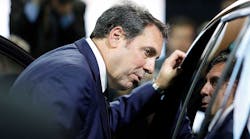GM Breaks with Trump Administration in Call for National Electric Car Mandate
The Trump administration wants to end California’s requirement for automakers to sell more electric cars in the state each year. America’s biggest automaker has a different idea: adopt the rule nationwide.
General Motors Co. (IW 500/4) plans to propose that federal regulators embrace a nationwide electric-car sales program starting in 2021, patterned on California’s so-called zero emission vehicle sales mandate that requires manufacturers to sell more EVs each year.
The plan, to be proposed in formal comments to regulators, is one of the clearest signs yet of auto industry opposition to the Trump administration’s proposal to cap federal fuel-economy requirements in 2020 and unwind California’s power to set its own vehicle efficiency standards and its zero-emission vehicle mandate. Honda Motor Co. also took exception to aspects of the Trump proposal.
The period for public comments to be filed ends at midnight on Friday.
“We know that we can do better” than the Trump proposal, Mark Reuss, GM’s executive vice president of global product development, told reporters in advance of the deadline. “We know that the industry can do better than that.”
GM says a nationwide program could put 7 million long-range electric cars on the road and slash 375 million tons of carbon dioxide emissions by 2030, compared with existing zero-emission vehicle mandates.
The Environmental Protection Agency and the National Highway Traffic Safety Administration in August recommended keeping federal fuel economy requirements at 37 miles per gallon from 2020 through 2026, instead of raising them to roughly 47 mpg by 2025 under rules by the Obama administration. The agencies also want to revoke California’s authority to adopt vehicle efficiency rules of its own, including its electric-car mandate.
The agencies said the proposal would reduce societal costs by as much as $500 billion over a number of years and highway deaths by as many as 1,000 per year, in part by making newer, safer autos more affordable. Industry experts and even some on the EPA staff have questioned aspects of the proposal.
While the auto industry sought relief from the Obama rules, carmakers view the Trump administration’s proposal as too aggressive. They fear it could force them to build vehicles for California and the 12 states that follow its standards, and another fleet for the rest of the nation, which Reuss said would be “very costly, and frankly unnecessary.”
Automakers also worry about a drawn-out court fight between Washington and Sacramento.
“GM is taking a leadership position in at least offering an alternative to what could be this endless battle between the federal government and California,” said Michelle Krebs, an Autotrader analyst. “Whether the administration will accept it, that’s another question.”
In a statement Thursday, the free-market Institute for Energy Research said the existing standards are too aggressive, effectively requiring automakers to produce electric cars that consumers still purchase in relatively small numbers. The group supports the proposed rollback, claiming manufacturers must raise prices of more popular autos to compensate for losses on electric vehicles, unfairly penalizing suburban and rural consumers who tend to be more concerned about driving range and reliability.
California and 18 other states plan to attack the EPA and NHTSA proposal as unlawful. California Attorney General Xavier Becerra on Wednesday called it arbitrary and capricious and said that it violates procedural requirements and EPA’s statutory obligation to reduce harmful pollution.
Industry Uncertainty
In its comments on the U.S. proposal, Honda said it disagreed with the Trump administration’s plan for revoking California’s rule-making authority and that key elements of the federal government’s analysis on traffic safety are flawed and should be scrapped.
Honda said pursuing the administration’s preferred option would “bring years of uncertainty for the auto industry” while state and federal regulators duke it out in court.
“A far better path would be for federal and state policy makers to negotiate a national program that is acceptable, if not ideal, for all parties including automakers,” Honda wrote.
Honda recommended that the EPA maintain greenhouse gas targets that grow tougher each year instead of freezing them as the agency has proposed.
“The industry is united in its request that the agencies work out an agreement with California,” Honda said in its comments.
After initially heated rhetoric when the proposal was released, U.S. and California officials agreed to hold talks to explore whether uniform standards nationwide can be maintained. Senior U.S. officials have also said they’d like to reach a compromise, but no deal has materialized thus far.
Krebs said GM is taking this step because it’s concerned that the U.S. could fall behind Europe and Asia in the development of electric cars. The automaker is also hoping officials will enhance the $7,500 federal tax credit for electric-car buyers, which will soon begin to be phased out over several quarters for GM, Tesla Inc. and others, she said.
To be sure, GM stands to benefit if the proposal gains traction. It’s readying a range of new electric cars and plans to begin an EV-based robotaxi business in the coming years. GM’s proposal seeks “additional consideration” for electric vehicles placed into autonomous ride-hailing fleets.
Reuss said a national electric car program would ease some of the challenges that this type of vehicle presents to all automakers.
“I believe it will facilitate more makers to be able to really focus on development of electric vehicles more efficiently and take the guesswork out of what we think may or not happen,” he said. “We’re making bets on a lot of uncertainty, which is highly destructive to capital.”
By Ryan Beene and John Lippert




